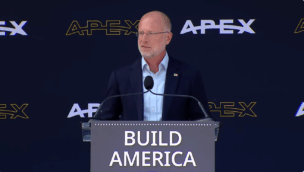The Trump administration has ordered the Pentagon to speed up its defense acquisition process—but that will require trained staff to quickly get new commercial tech under contract, according to Col. Richard Kniseley, the senior materiel leader of Space Systems Command’s Commercial Space Office.
“The Space Force is the smallest force that we have right now, and heavily reliant on some of our civilian personnel. As much as I love the focus on commercial, I’m going to need people to get this on contract,” he said at Payload’s Polaris After Dark event in DC on Monday night. “These are challenges we’re dealing with right now. I’m sure we will overcome them, but it will hamper us as far as moving the needle.”
His remarks highlight the tension between the EOs coming out of the White House, which call for both a reduction to the workforce and an improved process for buying platforms and services at the Pentagon.
Here are some other highlights from Polaris After Dark:
Advance payments: Kniseley said he is working with the House Armed Services Committee to adopt more commercial practices for the military, saying he submitted a request to provide advance payments. “You do have believers out there in Congress,” he said. It’s unclear how we might see movement on that, but we’ll be watching to see if it comes up during the panel’s NDAA markup this year.
Outside money: Defense officials are working more closely with investors to better telegraph their plans and desires and—hopefully—help more private dollars flow into tech to benefit national security. Omar Pimentel, DIU’s policy and strategy lead for space, said investors often approach the unit wanting to financially back platforms that DoD could purchase in the future.
“DIU has been seen as a good avenue for prototyping and demonstrating hardware and software capabilities,” Pimentel said. “But I’m even more excited—and we hope to have some announcements soon on this—[that] we’re beginning to prototype processes as well.”

Ain’t no stoppin’ us now: The GAO issued a report this year raising concerns about the maturity of some of the tech in SDA’s rapid iteration programs. SDA policy chief Paula Trimble said the agency is taking the GAO’s recommendations to heart—but that the SDA won’t slow down.
“We’ve been hearing for years that we’re not taking enough risk in defense acquisition,” she said. “Someone has to lean in, and I think SDA is for the time being that leaning-in factor….We’re going to take the time to look at the recommendations and implement them, but I don’t really see SDA slowing down.”
Happy birthday: DoD’s Commercial Space Integration Strategy turned a year old this month. Kniseley highlighted a few major wins for the Space Force’s effort to boost cooperation with the private sector, including:
- Space Systems Command’s Front Door program, which predates the strategy, now has 850+ companies learning how to work with DoD;
- The Orbital Watch program, established this month, will share unclassified threat information with companies quarterly;
- An increased commercial presence at military space war games.
Pimentel also highlighted a line in the strategy directing DoD to help companies clear regulatory hurdles when there’s a national security imperative. He said DIU is working with agency officials to find “the biggest places where commercial industry and regulators aren’t seeing eye to eye.”
Number one: The SDA is preparing to launch its Tranche 1 satellites this summer, which will be fully operational for troops in 2027. While Trimble said commanders are eager for the constellation to come on line, she also hopes the batch of satellites will prove to others around the DoD that SDA’s rapid iteration works.
“Haters are gonna hate. We still have a culture that is very rooted in legacy processes and systems, and I think we’re going to continue to be the first one out in the field trying to do things in a new way,” she said. “Once we deliver Tranche 1, I think a lot of heads will turn. I’m hopeful that we’re nearing a place of acceptance where we’re no longer the new kid on the block.”
Final flight: Kniseley’s remarks at the event were his last in his current role. We’ll be watching to see what he does next!




